An Update on Phabeni’s Health – Blood Transfusions and X-Rays | PART 2
Dearest HERD friends! We have been very busy behind the scenes and have been compiling the most accurate version of the events that played out last month concerning a drop in Phabeni’s health. Following on from part one which we shared in a blog, we now can inform you about the plasma transfusion that followed.
By Adine Roode
It was forecast to be a hot day and so we decided to start at 6am with the transfusion procedures. I chose Mambo to be the blood donor for little Phabeni. First, we had to sedate Mambo before putting in the IV line. Usually when you donate blood, you don’t feel anything except the little prick, however they supply you with juice and perhaps a sweet cookie in South Africa, should you not feel well. With the elephants, there is of course no way that they will allow Dr Rogers to prick them with a needle. A standing sedation works well with the elephants. Our elephants have in fact played an integral part in the research of BAM, the abbreviation for a combination of butorphanol, azaperone and medetomidine administered in a standing sedation.
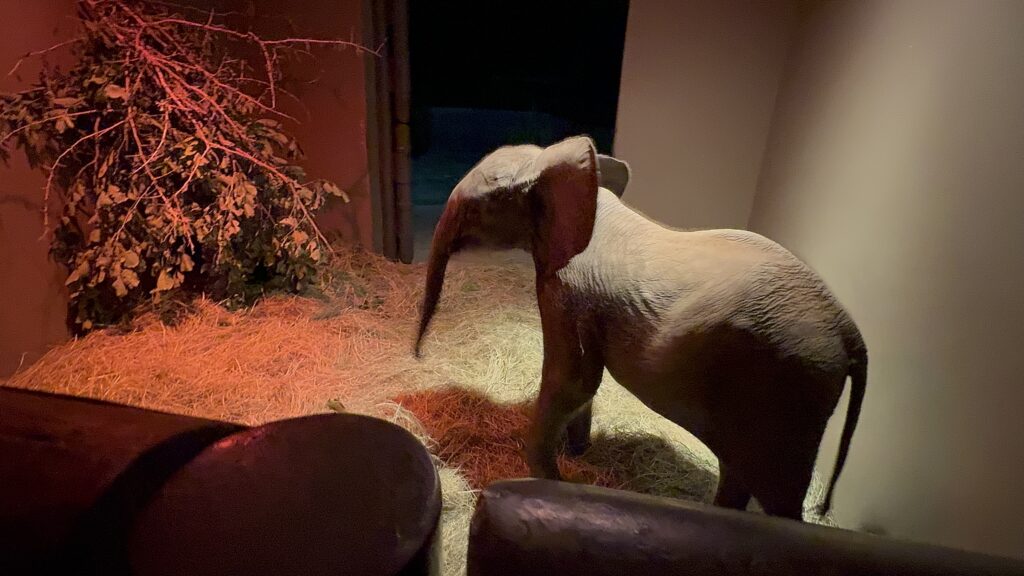
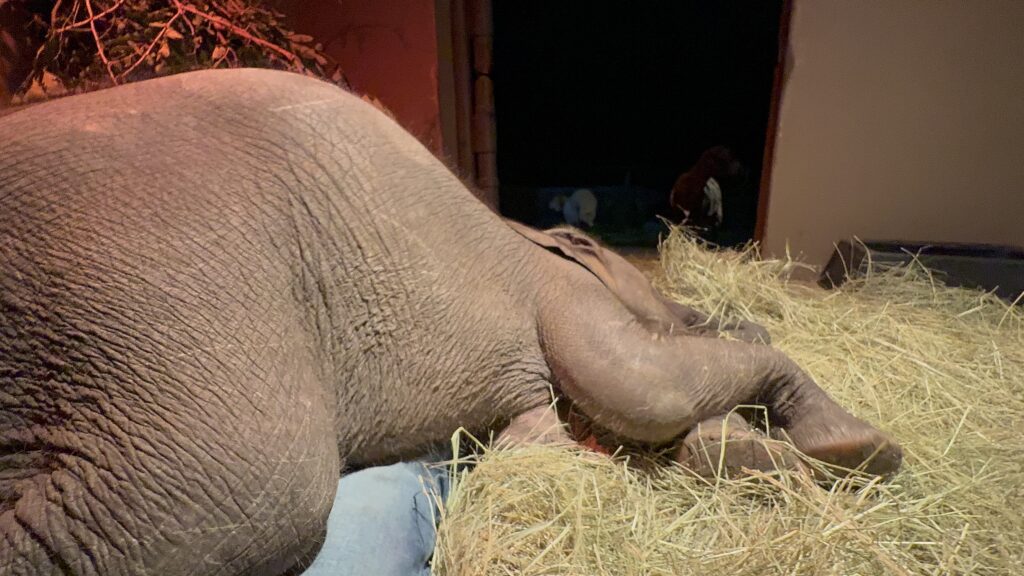
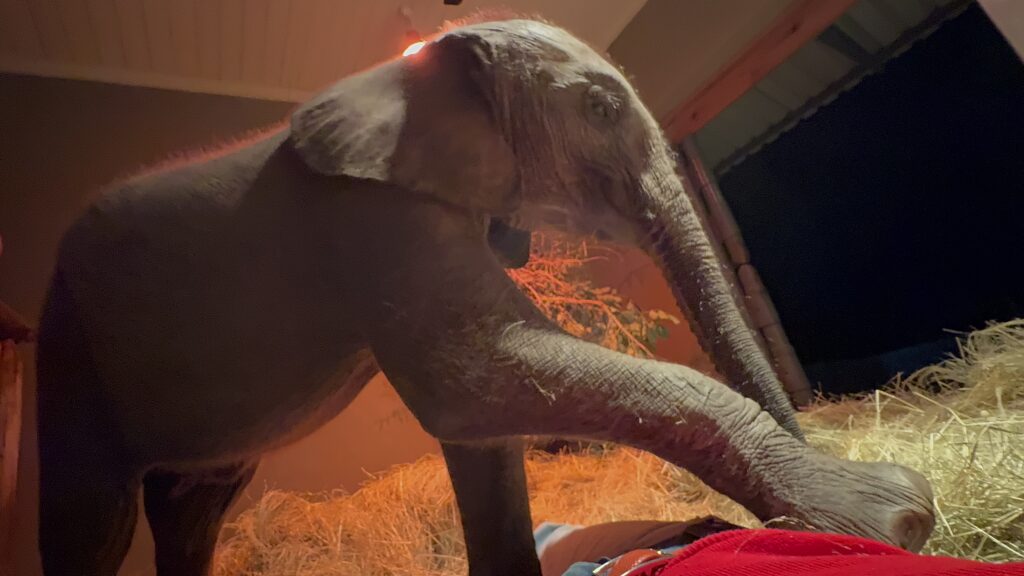
It was a cool morning still and we were concerned that we would not easily find a vein to draw blood from, but luckily Mambo’s veins in his legs were good and we could fill two pints of blood. When choosing a donor, you look at a healthy animal as you want to restrict transmission of diseases.
Previously with other calves, we used Setombe as the blood donor, but because she has an important role to play in caring for Phabeni now, she wasn’t an option this time. Mambo was a star donor. While Mambo was sedated, the herd was close by and the carers fed them lucern to keep them occupied. After Dr Rogers reversed the BAM, Mambo joined the herd again, and we moved over to Phabeni at the orphanage.
Blood transfusions have been practiced over centuries for both humans and animals and have saved many lives. In 1665, Richard Lower did the first blood transfusion in history on a dog. Blood transfusion became more popular in animals after the techniques and equipment used improved during the 1950’s. As in humans, animals do have different blood types, however we are not aware of blood types in African elephants – perhaps this is a research study that we can put on our to do list.
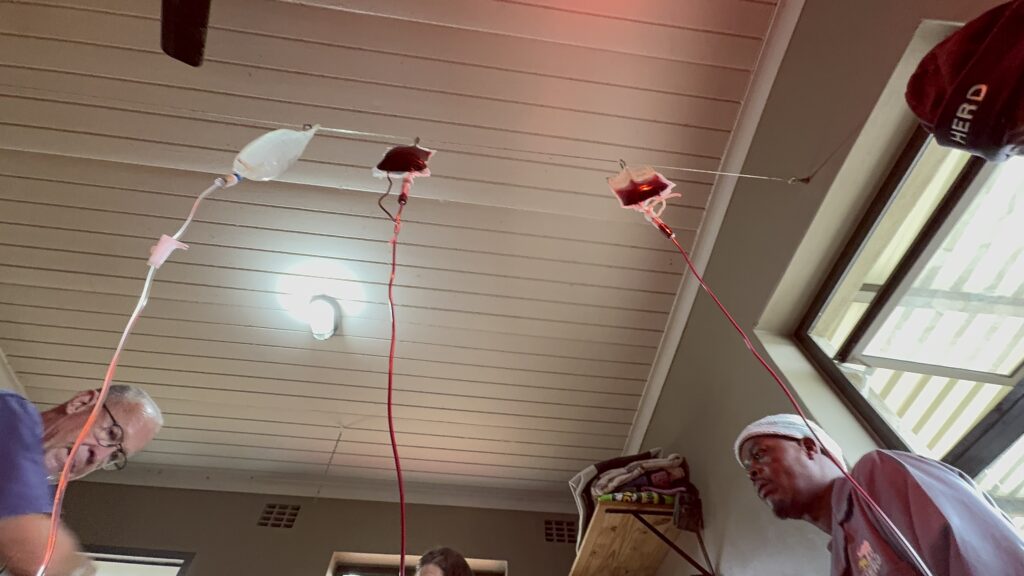
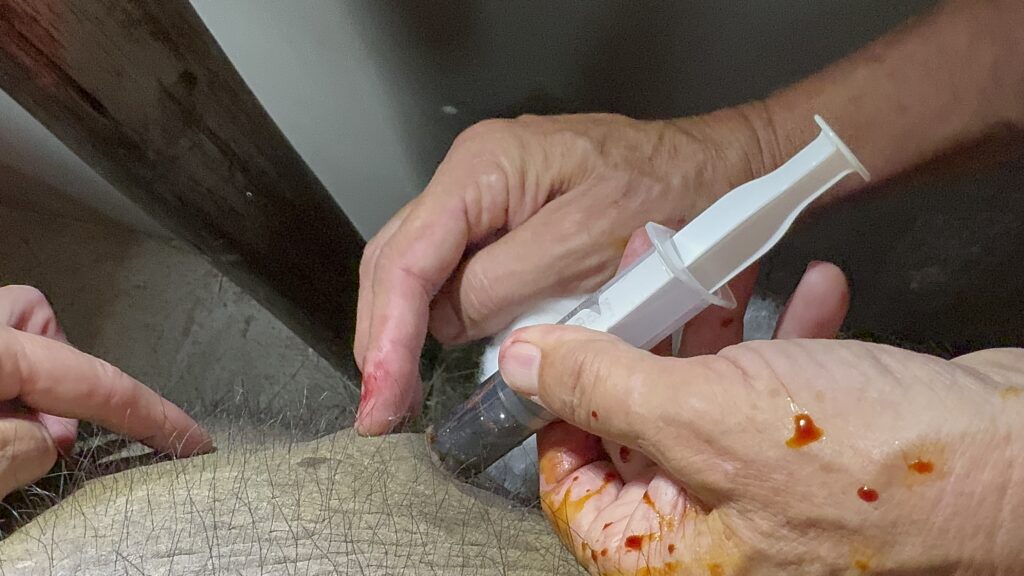
The week prior to the transfusion was tough with Phabeni not drinking all his milk bottles, as well as undergoing two previous sedations so that we could clean the wound you will have seen on his rear. We had also administered drips to prevent dehydration. Interestingly enough, Phabeni’s energy levels were always good, but I think the fact that he was out with the Jabulani herd every day meant that he ate a lot of grass, leaves, bark and some roots that the bigger elephants would drop and share with him. Therefore he was getting in a good ‘batch’ supplementation to his milk. Although the second set of blood results showed an improvement on his amylase counts, we noticed that the wound on his rear was swollen again.
The main indication for Phabeni’s blood transfusion was the treatment of anemia and chronic inflammation because of his wound, but also because in all of our orphan calves at the age of 11 months there is a dip where they struggle with their health, and stop taking bottles. Thus, a secondary reason for doing a blood transfusion was to maintain Phabeni’s health and prevent a serious dip, where you suddenly need to fight for a life. We are fortunate that this is an easy option for us since we have access to elephant blood donors who are strong and healthy.
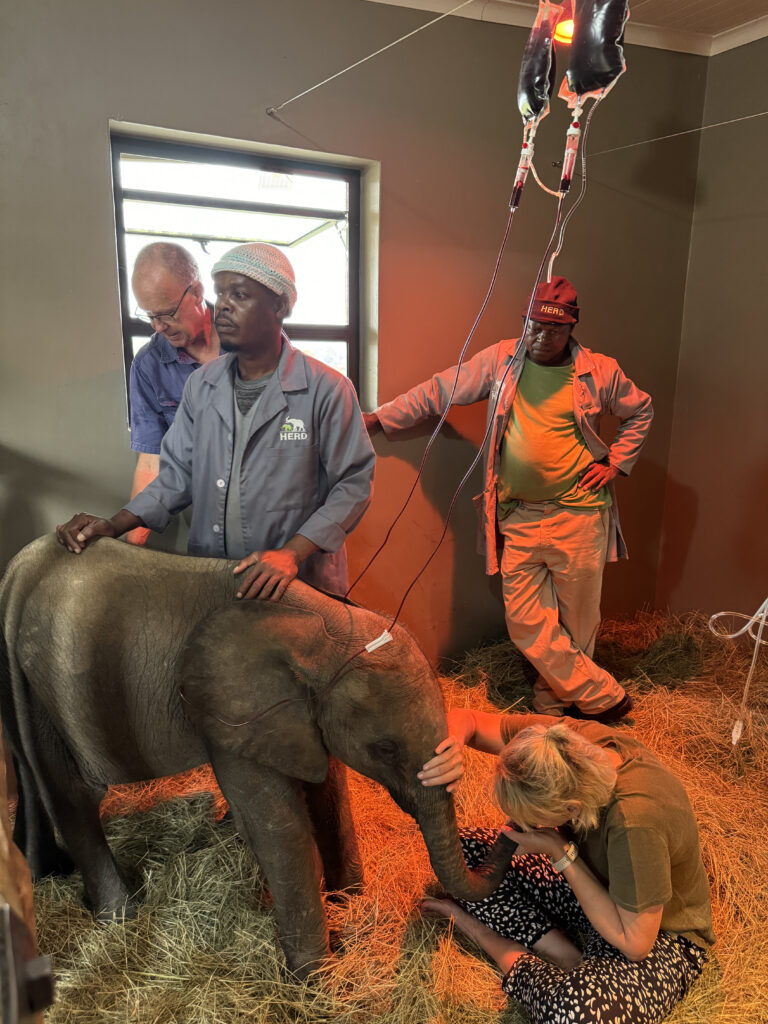
Unfortunately wildlife vet, Dr Johan Marais was unable to attend to the X-rays at that time and we were still uncertain on what the exact reason is for the wound on Phabeni’s rear not healing properly (a wound caused we think by the tranquiliser dart during his rescue in November 2023).
Once again Phabeni was darted with BAM. It took approximately 20 minutes for him to be totally ‘out’. As he had two drips in the previous seven days, it was tricky to get a vein in his ear, but luckily with Dr Rogers’ experience, he was able to find a vein for the IV. As blood is thicker than saline, it took more time for a transfusion, compared to a drip. Excessive and rapid injection of blood and plasma can result in circulatory overload and heart failure. Blood should be given intravenously at a rate of 10mL/kg per hour – starting the transfusion slowly and gradually increasing the flow rate. Warm blood as in this case, should also be transfused over four hours. The volume of blood is determined by the recipient’s body weight and reason for transfusion. During 2017, we administrated four pints of blood for Timisa during a transfusion. Khanyisa also received blood in 2020. The amounts are assessed by Dr Rogers after we discuss the clinical observations and previous blood results.
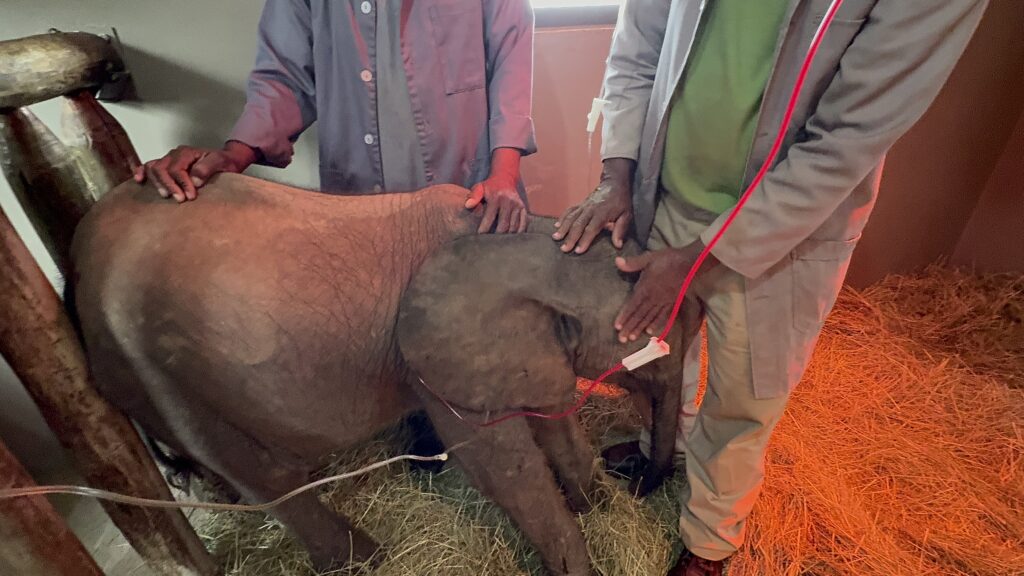
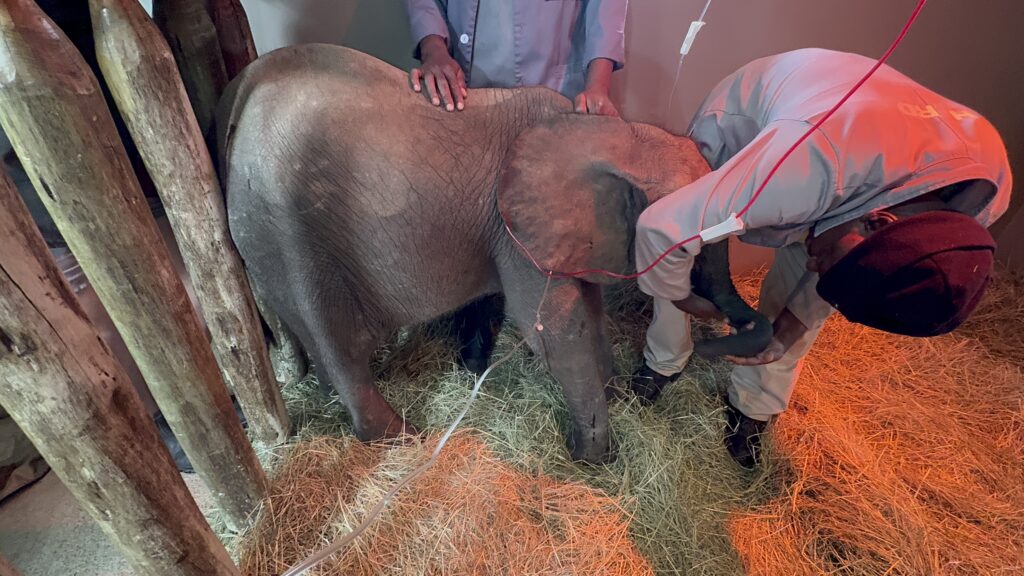
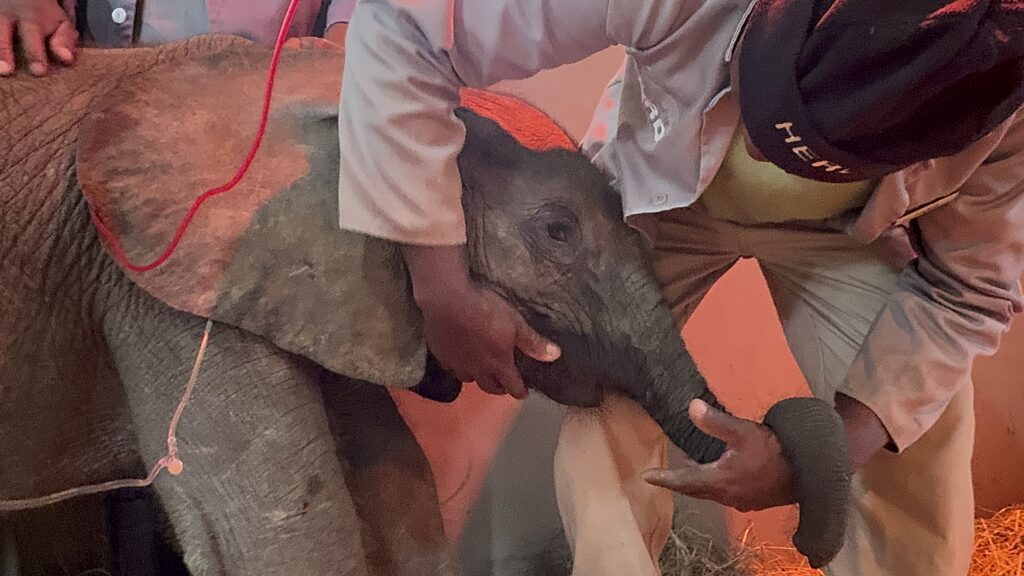
We gave Phabeni two pints of blood as well as drips to make sure that he was well hydrated. Sedation is always risky and vitals need to be checked and monitored the whole time. During sedation, the elephants maintain their natural physiology reflexes and are capable of breathing on their own. But one of the reasons why I choose to be present during any sedation is that we have lost a calf under sedation before, and we nearly lost Khanyisa once under sedation. If I had not picked up on her breathing issue and were Dr Rogers and his assistant Janelle not extremely fast in handling the situation and reversing the sedation, we could have lost her – a thought I can’t bear to think of. The fact is, when a calf is sedated because he is sick, he is already weak and therefore more prone to stop breathing under sedation.
Luckily all went well and after the sedation was reversed, we gave Phabeni some time to be himself again, while Reply prepared his bottle. He drank the milk eagerly before stepping out of the nursery into the orphanage. Setombe and Lundi joined the carers to fetch Phabeni and the little bull left the orphanage just before 11 am to join the herd for the rest of the day in the bush. Keeping him in the orphanage would increase his stress levels as he doesn’t understand why he can’t go out. We didn’t go too far from the homestead though, and fed close by, while we continued monitoring Mambo and Phabeni closely.
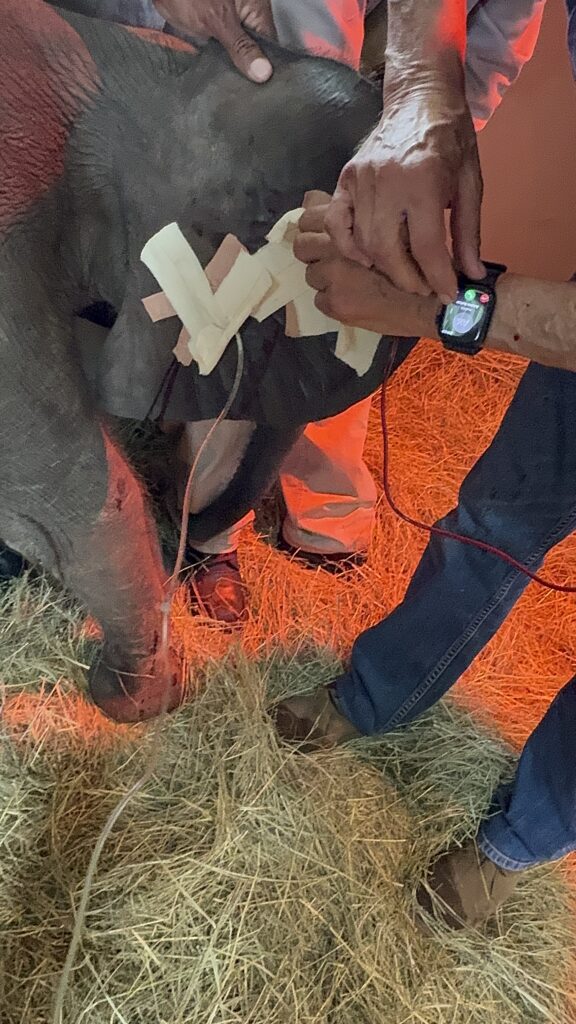

We were so relieved and satisfied that all went well and that our little fighting fit bull took all his milk bottles.
A week later, Dr Johan Marais was back at his office and he could check the X-rays that he took of Phabeni. The feedback from Dr Marias on the radiography was as follows: “I manipulated the X-rays to be able to see clearly as theoretically there should be dead tissue. When you have a wound on a human or animal that keeps on popping up open – so it heals and pops open, then it heals and pops open – that means there is a foreign body or object inside which the body is trying to get rid of. That foreign body can be anything from a needle, a piece of material, a dead piece of bone, a dead piece of tissue or a piece of wood and all of that classifies all as a foreign object that the body wants to get rid of. I can see clearly in two of my X-rays that there is definitely a fracture of the tuber coxae that you also get in horses and remember I also told you that it always pulls down – ventral – and this is exactly what happened here.”
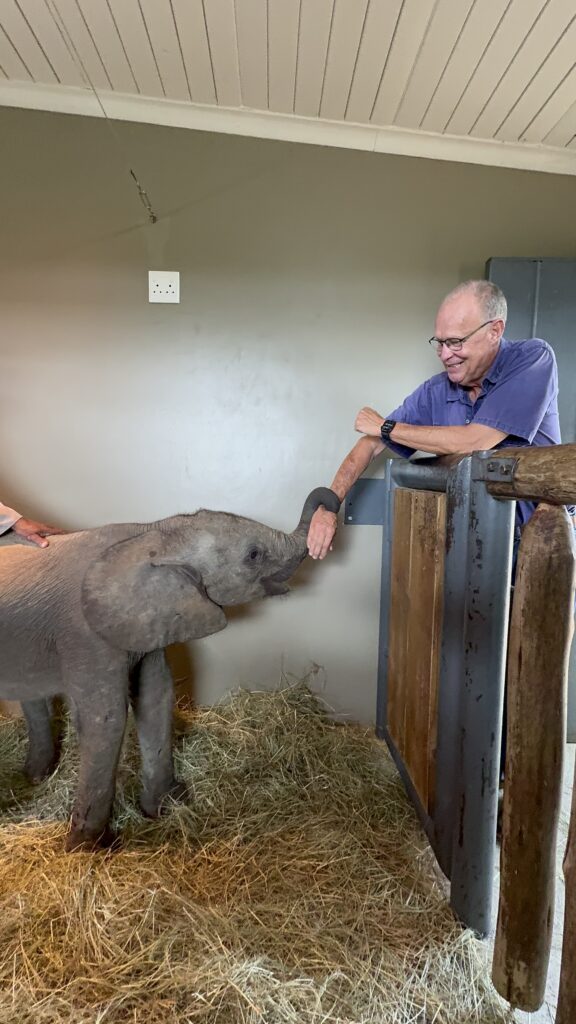
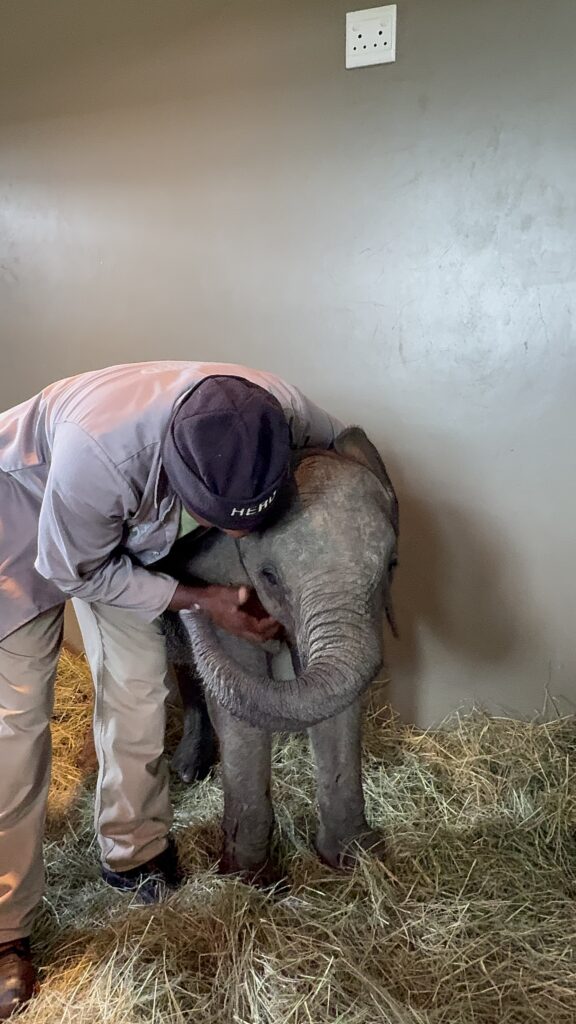
In Phabeni’s case, what seems to be the case in the X-rays was that there was a fracture, a little piece of bone broke off and was pulled ventrally down towards the ground and is sitting about 7 cm ventrally of the wound. It is about 1,5 or 2cm deep, so it is not that deep, which is good. One should remove this foreign object or piece of bone if the wound keeps repeatedly healing and opening, otherwise this wound will never heal, but that should not make the animal sick per say. It is only a local wound and they would not get an infection from the foreign object, just a local wound. Of course you can get a secondary infection if the wound is infected by bacteria from the outside.
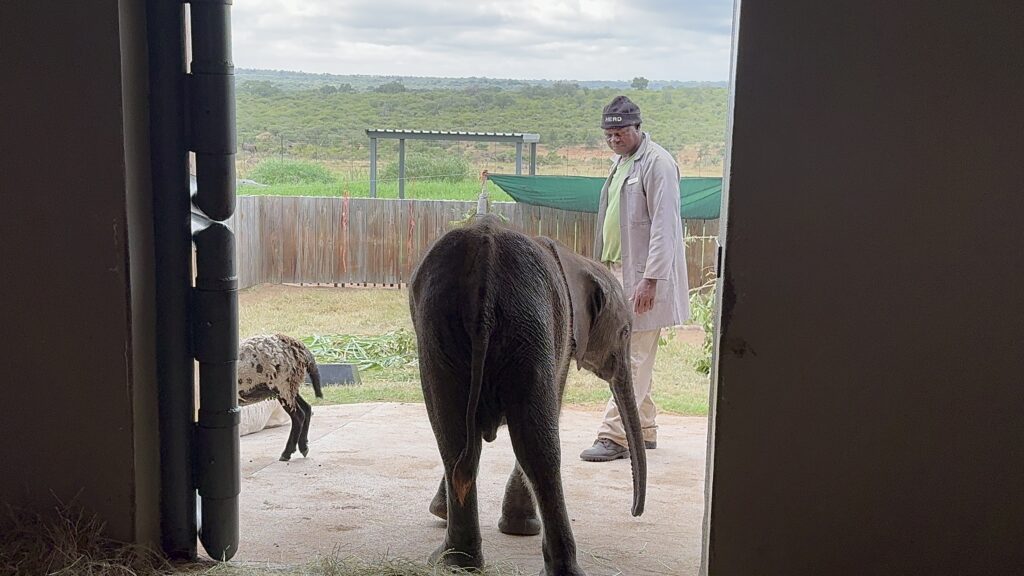
It can be quite difficult to find this piece and is not easy always to cut into the elephant to find it, so we always use X-rays or ultrasounds just before we do the operation to increase the success of the operation and finding the foreign piece of material or bone to remove it. Alternatively you can leave it if the wound heals, as the tuber coxae has good muscle attachment which is the reason the piece of bone there is pulled down and has good blood supply and won’t necessarily die. If it dies, you will need to go and get rid of that piece, but you never get it in horses. If it didn’t have the muscle attachment, it would have still been sitting higher and Dr Marais is comfortable that the muscles pulled the piece down and still has blood supply. It is typical of what happens in horses and they will be very sore for a time, but will be fine in the long run. Dr Marais told me that it is called a dropped hip.
At this stage, we are still closely monitoring Phabeni’s wound. The other day it seemed that the wound was swollen, but it seemed that after he drinks his milk, it looks swollen as his tummy is bulging more. It is not warm though and hasn’t opened again. Touch wood, Dr Marais is right and it has healed on its own meaning that a procedure to remove the piece of bone is not necessary. Should it open again, we would need to get Dr Johan Marais in to assist again with his X-ray machine and sonar, so that we can know exactly where the piece is stationed and then Dr Rogers can be exact when removing the piece.
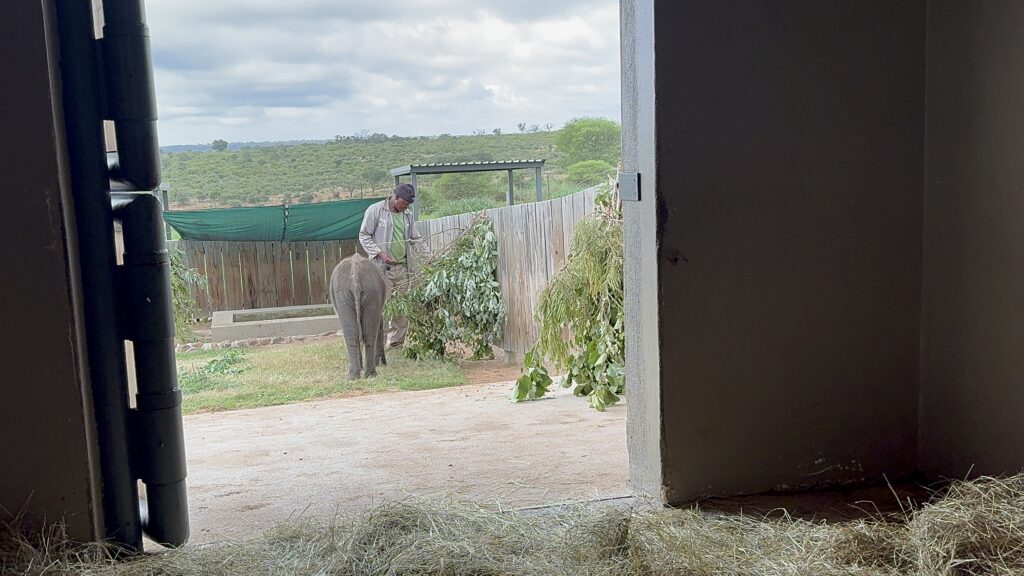
For now, all is good except for every now and then when Phabeni does not taking the occasional bottle of milk. We are adapting the milk as he is heading to one year of age, more or less. The process of adapting milk volumes and ingredients is a typical part of looking after elephant orphans. There is not a single recipe for all elephant orphans and we need to keep tweaking things to fit the best recipe plan for that specific calf. Once they get older, it gets easier, but for now it takes time, knowledge, patience and staying openminded so that we do not miss any of the signs that our little Phabeni shows us.
Thank you for your concern and support for Phabeni and for caring about his continued well-being. We will always keep you updated as the months tick on. You will know, if you watched our journey with Khanyisa, that raising elephant orphan calves is tricky work filled with ups and downs, and as such our team is ready and equipped to deal with each challenge.

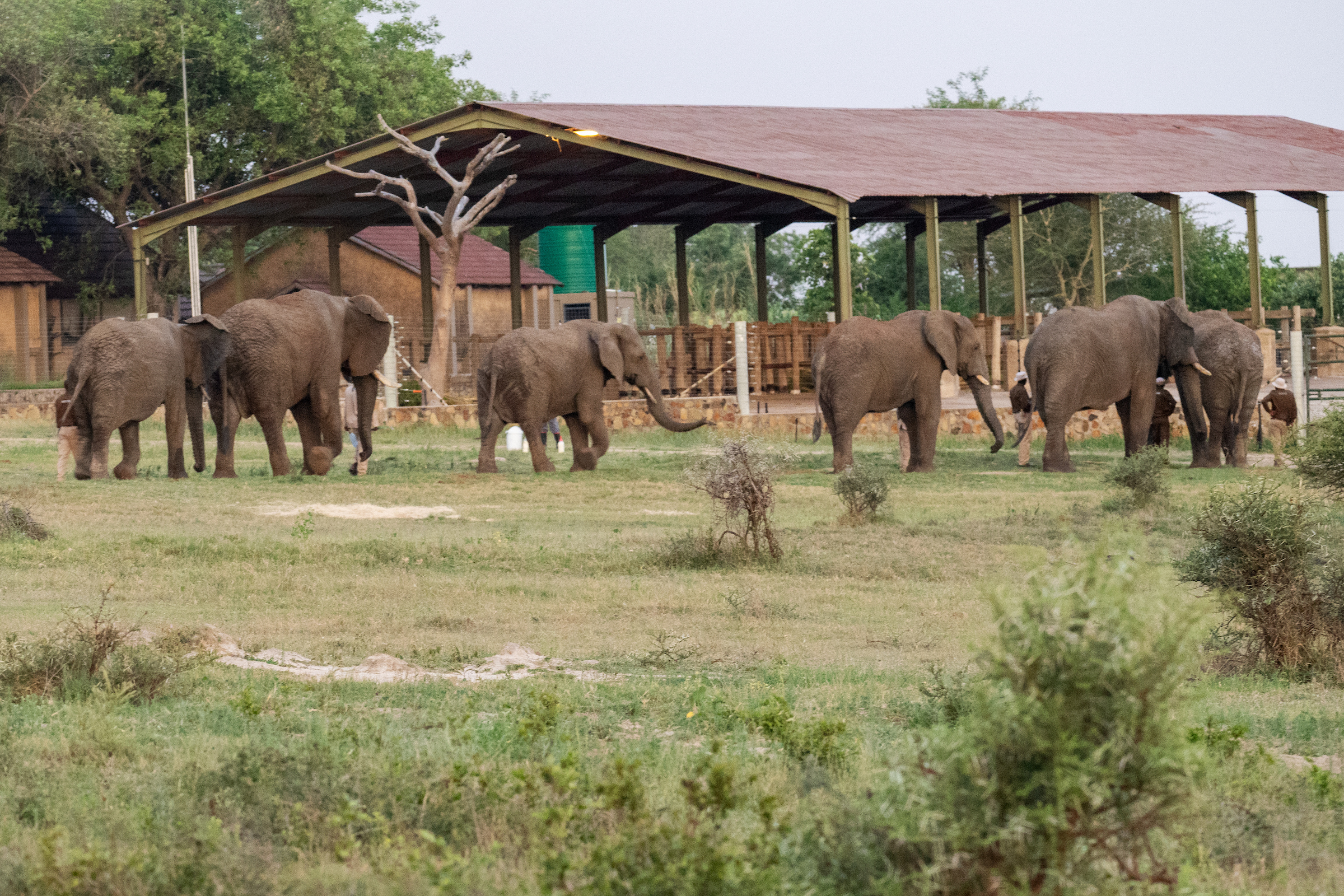
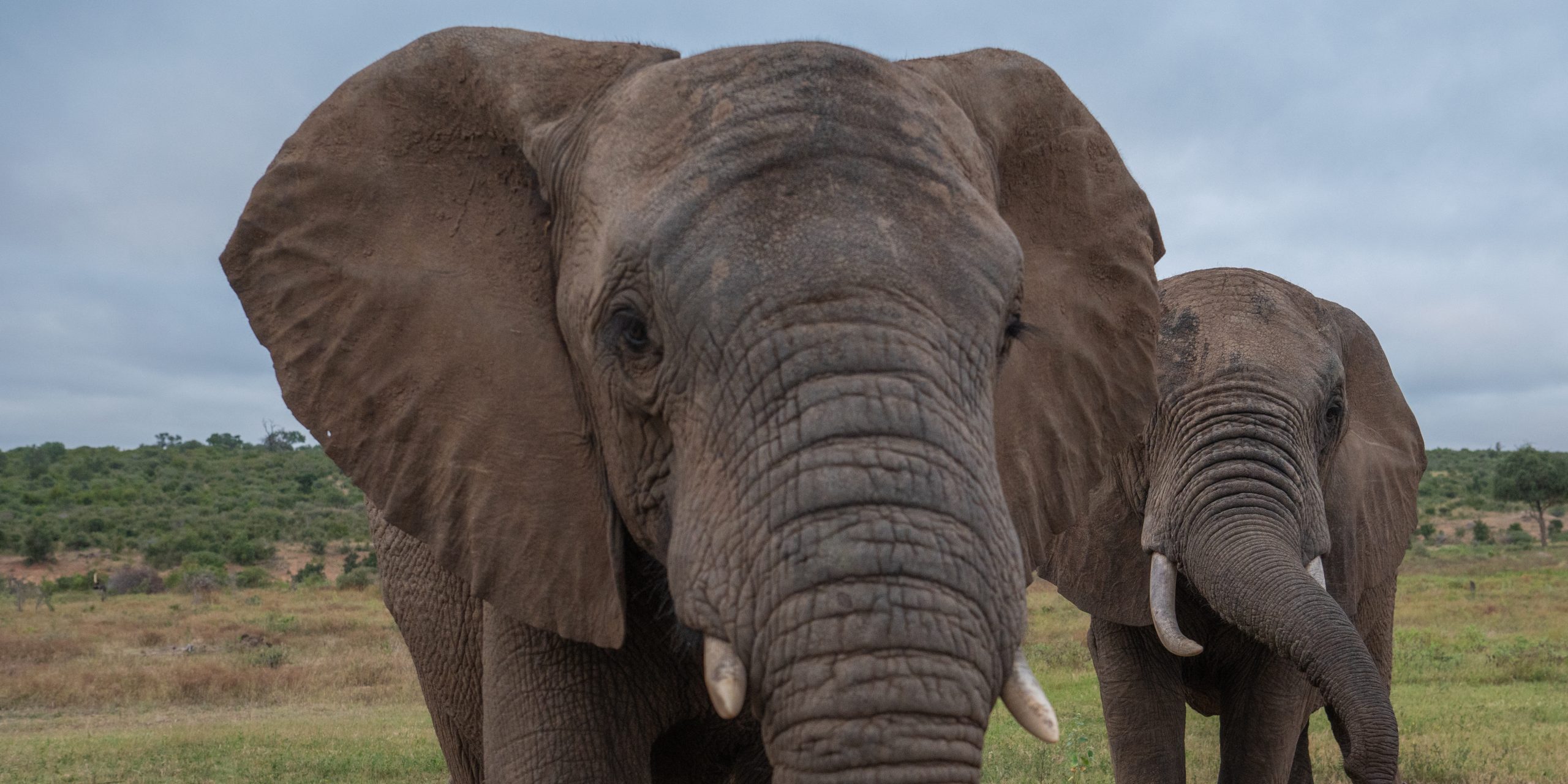
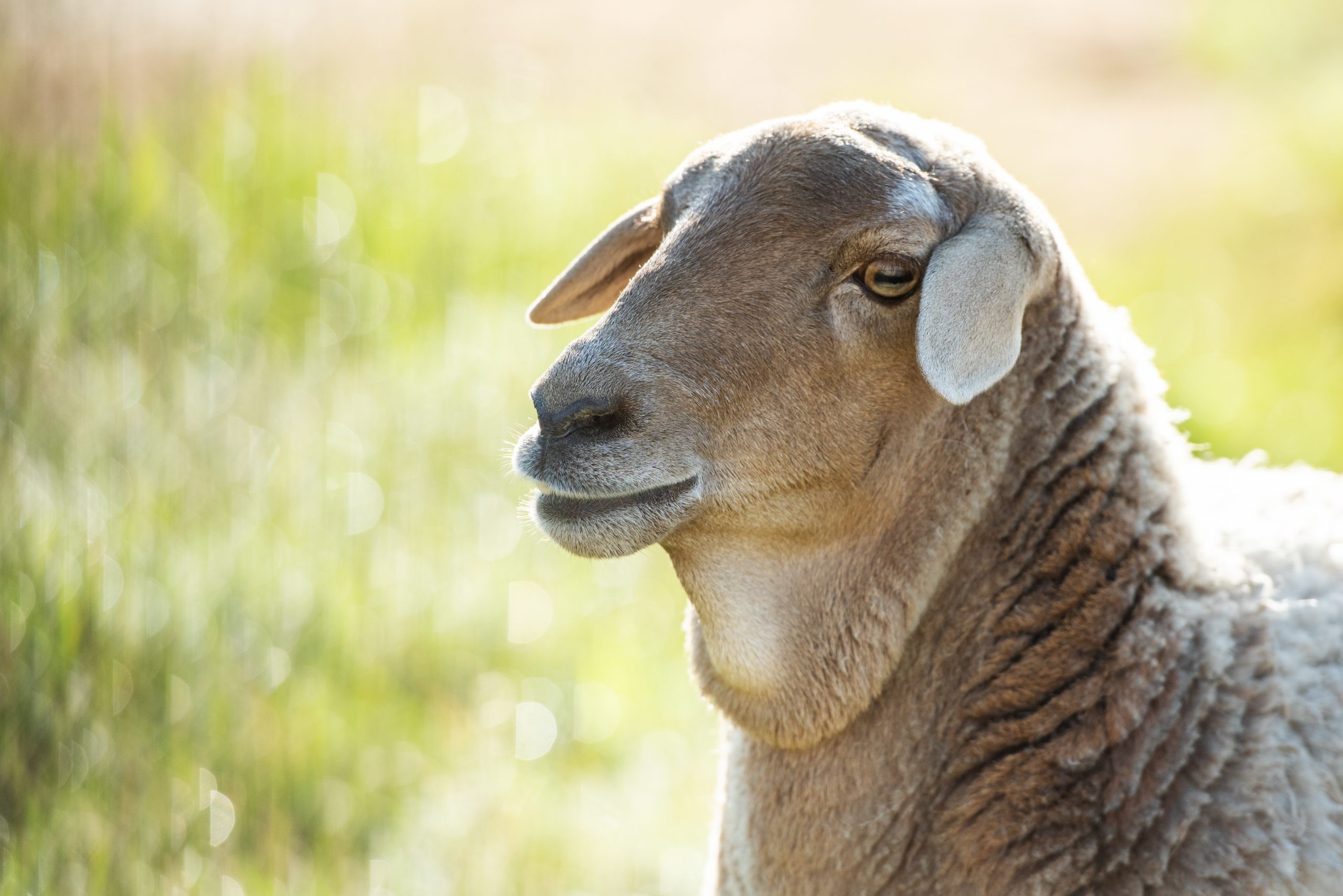

Nicole
Thank you for your support. The impact he had on HERD and the elephants in our care will live on forever.
Dorothy ( Dori) Walker-Dorman
Adine, I am so very sorry for you and all the carers who loved, supported and provided nutrition to orphan baby Phabeni. I am so sorry for your loss. I am sorry for Setombi and all of the elephants who took Phabeni in as their own and made him part of the herd. I am just so incredibly sorry.......
Charles hart
Thanks for your tireless work with these amazing beautiful animals!